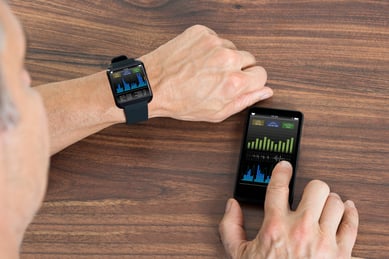 Considering how long it can take to make a global shift in corporate America, the rise of wearable fitness trackers in wellness has been meteoric. A recent study reports an anticipated 13M wearables will enter the corporate wellness market by 2018. Despite the rapid adoption of this technology by businesses for their employees, there remains healthy skepticism about what exactly is being measured and who is privy to that data.
Considering how long it can take to make a global shift in corporate America, the rise of wearable fitness trackers in wellness has been meteoric. A recent study reports an anticipated 13M wearables will enter the corporate wellness market by 2018. Despite the rapid adoption of this technology by businesses for their employees, there remains healthy skepticism about what exactly is being measured and who is privy to that data.
It would be tempting, I think, for an employer to see wearable tech as the answer to their questions about how to have an employee wellness program. The devices are relatively inexpensive and generally easy to use. And many adults already use a device without it being connected to a corporate wellness program, so there is no introduction of something foreign to which the workforce must adapt.
But the easy answer isn't always the right answer. Here are three reasons why wearable fitness trackers aren't your wellness program.
1. It's not always about the numbers.
Despite the continued drumbeat for measurement, ROI, and quantifying value in wellness, providing opportunities for your employees to live well isn't always about the numbers. If you're offering a wellness program and your only goal is to save money on healthcare costs for the business, you're (dare I say) probably doing employee wellness for the wrong reasons.
Your employees are people—people with complicated and busy lives. If you want them to live well, you may want to rethink your desire to hook them up with a tracking device that's going to report on everything from steps to sleep. You might view it as a perk, while employees see it as more pressure.
If you insist on wearables in your wellness program, consider them as an option among many other tools your workforce can choose from to live well in ways that are meaningful to them.
[Related Content: Why Employee Purpose might be the Heart of Corporate Wellness]
2. Like most programs under the corporate wellness banner, one size does not fit all.
If you're a fan of using a tracker personally, it may come as a surprise that they're not a good choice for everyone. Some people are quickly defeated by the constant barrage of information, so instead of serving as a device to motivate individuals, they have the opposite effect. Other people quickly turn to obsession with the data, constantly feeling like they need to do more, move more, sleep better, etc., to the exclusion of other more important activities (like work). As eloquently stated in this personal account, "...there is a fine line between health consciousness and a health obsession...."
While this study on wearables points to a 53% adoption rate for the under-40 employee crowd (note that the adoption rate for the over-50 employee group was at 36%) as a good thing, I'm left to wonder...what about the other 50+% of your workforce? If you insist on wearables in your wellness program, understand the potential reach as well as the potential concerns among your employees. Diversity in your offerings acknowledges the varied interests and passions of your employees.
3. High-tech has a place, but so does high-touch.
I've written about high-tech vs. high-touch in corporate wellness before. Wellness isn't an either/or proposition when you consider high-tech and high-touch options. You need sophisticated tech solutions to understand what is and isn't working in your wellness program. Still, there are limits to what technology can do for your business when it comes to helping employees live well.
For the employee who is caring for his parents who are aging in place with dementia, the wellness tracker does not get him more engaged at work or taking more steps; it only leaves him feeling more alone in his caregiving situation. It doesn't provide support for him while he struggles to figure out how he's going to get dinner to his parents and still make it to his son's baseball game. But if he has a relationship with the wellness manager (high-touch), he might open up about this personal situation. Then the wellness manager can help him find resources through the EAP or the local-area agency on aging.
***
Your amazing employees are complex and they need a variety of tools at their disposal to live well. Wearables aren't the answer; they're just a piece of the puzzle. Need to think outside the wearable option? Grab these seven ideas for how to make movement easy at work.

